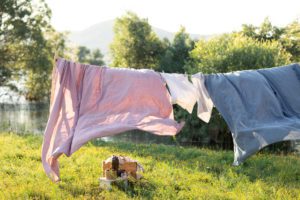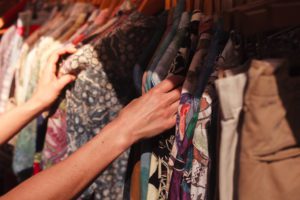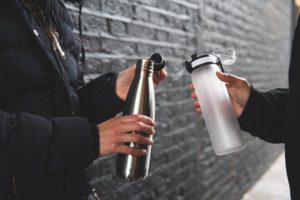It’s more important than ever to be environmentally conscious. Incorporating eco friendly habits into our lives, no matter how big or small, can contribute to building a more sustainable life. But how does one go about implementing these habits? What exactly is eco friendly, and what isn’t? This guide will tell you exactly what to do and what not to do to make your home as environmentally friendly as possible. Even if it’s just a small change, everything counts in the fight against climate change.
Lead the way with LED

A person or household’s carbon footprint is related to the amount of electricity consumed. Swapping out incandescent lights for LED battery-powered lights is one of the most environmentally friendly things you can do.
LED lights use less energy to produce the same light output as other lamp options; so while we’re not saying swap them all out, making a conscious effort to use them more than incandescent ones it can greatly save your energy bills in the long run. On average, LEDs use 80% less energy compared to incandescent light bulbs.
Not only that, but they last much longer than lightbulbs too. And of course, less lightbulbs means less disposal, reducing contamination to our environment and our landfills.
Summer Shortcuts

When it comes to drying our clothes, many will choose the easier option and dry our clothes in a dryer. However, if it’s a dry and sunny day (we’re thankful that it’s just a dry day here in Ireland), why not take advantage of it and line-dry your clothes?
Line drying is often less chosen since it takes more effort and longer to complete. However, if you’re looking for ways to be eco-friendlier and more sustainable, we suggest taking your clothes out to dry in the sun.
There are many advantages to air drying-it will save you spending money on repurchasing clothes in the future as they won’t shrink or shrivel away every time it’s in the dryer.
Tossing and tumbling in high heat can cause wear and tear and even strain on your clothing. For a more gentle and viable option, line drying is free from the hustle and bustle of a dryer. The natural heat from the sun will do that work for you.
Conserve and Preserve

Looking for an easy and cost-effective way to reduce your carbon footprint? The average shower head uses 2.5 gallons of water every minute. That’s a lot of water and can really add up across the whole nation.
Reducing the amount of water used in daily showers can be a simple way to conserve water and electricity. It may not seem like a lot, but if we all decided to shorten the time we spent showering then it can really make a difference. By reducing your shower by just a few minutes, you could save 25 gallons. That’s enough to pee and flush 4 extra times per day! According to Do Action List, only 0.0007% of the Earth’s water is drinkable, and about 1.5 of that is used in our showers!
It’s a no brainer really; easy, affordable, and eco friendly. Shortening showers is one of the best ways to help the planet.
Get thrifty

Thrift shopping may not be everyone’s cup of tea, and that’s okay. But did you know that, according to American website CoverGirlShapeWear.com, if 300 million people reused one single T-shirt, nearly 210 billion gallons of water and 1 million pounds of carbon dioxide would be saved? Talk about eco-friendly, right?
It’s true. One small and simple gesture can really make a difference in the long run. Thrift shops also allow you to unleash your creative side due to the wide range of styles. Not only will you be strutting a new style, but you can save lots of money by going vintage. Prices in thrift shops are fractions of what they are in large retail shops, and you can buy just as many things as you would in them while spending a lot less. Win-win, right?
And there is so many great charity shops around with some amazing and unique gems. Have you checked out Nine Crows Vintage Shop, Slaughterhouse Vintage, Oxfam, and Vintage & Classic Shop? Some great fashion and styles suited to everyone-and sustainable too!
Reduce, re-use, recycle

Year after year, we see heartbreaking images of the oceans littered with plastic. So much waste ends up in the oceans, forming large islands consisting entirely of discarded rubbish.
Large proportions of the waste we see is plastic, and only one in five bottles are actually recycled properly. One of the best ways to incorporate more environmentally friendly efforts into our lives is by using re-usable water bottles. Plastic bottles take 1,000 years to biodegrade, so by using a re-usable product you’re essentially saving the planet with every drink.
They’re convenient, relatively cheap (you would certainly be saving money in the long run) and often come in stylish and trendy designs. But most important of all, they’re eco friendly and help relieve the burden wreaked on Mother Earth’s oceans.
If you’re going to be using re-usable bottles, you should try out re-usable cups too. Have you heard of the KeepCup? An Australian brand with markets all over the globe, they’re taking the re-usable cup business by storm. They manufacture reusable coffee cups perfect for on the go coffee lovers. It was founded in 2007 by Abigail Forsyth and her brother Jamie Forsyth after they grew concerned about the volume of single-use coffee cups. As of 2019, KeepCup estimates that its users have averted billions of non-recyclable, single-use cups from landfill-how incredible is that! Affordable, stylish, and sustainable, there’s no excuse to have a re-usable coffee cup.
In a world that is sill coming to grips with the Covid-19 pandemic, it’s easy to forget that climate change is still a real and luring threat. Whether you decide to buy a reusable cup or bottle, reduce your meat intake, or buy second hand, any little changes you can make in your household towards living a more sustainable life will go a long way. Don’t forget to tell your friends, family, or colleagues of ways to incorporate more eco friendly habits into our lives-it will help develop a greener conscious. Every step counts!
